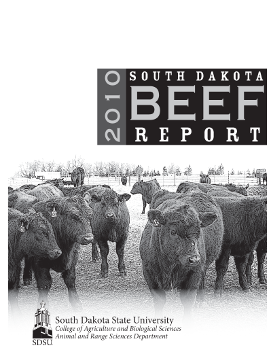Document Type
Report
Report Number
2010-12
Publication Date
2010
Summary
Conventional wisdom among rangeland professionals has been that for long‐term sustainability of grazing livestock operations, rangeland should be kept in high good to low excellent range condition. Our objective was to analyze production parameters, economic costs, returns, and profit using data generated over a thirty‐four year period (1969‐2002) from grazing a Clayey range site in the mixed‐grass prairie of western South Dakota with variable stocking rates required to maintain pastures in low‐fair, good, and excellent range condition classes. Cattle weights were measured at turnout and at the end of the grazing season. Gross income per acre was calculated by multiplying total gain per acre times price using historical National Agricultural Statistics Services feeder cattle prices. Annual variable costs were estimated from a historical yearling cattle budget developed by South Dakota State University (SDSU) agricultural economists. All economic values were adjusted to a constant dollar using the Bureau of Labor Statistics’ Consumer Price Index. Stocking rate, average daily gain, total gain, net profit, gross revenue, and annual costs per acre varied among range condition classes. Net income for low‐fair range condition ($11.18 per acre) and good range condition ($11.86 per acre) were not different, but both were greater (P < 0.01) than excellent range condition ($ 9.31 per acre). Over the life of the study, real profit (adjusted for inflation) steadily increased (P < 0.01) for the low‐fair and good treatments while it remained level for the excellent treatment. Neither drought nor wet springs impacted profit differently for the three treatments. These results support generally observed rancher behavior regarding range condition: to maintain their rangeland in a lower range condition than would be normally recommend by rangeland professionals. Ecosystem goods and services of increasing interest to society and associated with high range condition, such as floristic diversity, hydrologic function, and wildlife cover, come at an opportunity cost to the rancher.
Number of Pages
5
Format
application/pdf
Language
en
Publisher
South Dakota State University
Rights
Copyright © 2010 South Dakota State University.
Recommended Citation
Dunn, B.H.; Smart, A.J.; Gates, R.N.; Johnson, P.S.; Beutler, M.K.; Diersen, M.A.; and Janssen, L.L., "Long‐term Production and Profitability from Grazing Cattle in the Northern Mixed GrassPrairie" (2010). South Dakota Beef Report, 2010. 13.
https://openprairie.sdstate.edu/sd_beefreport_2010/13


